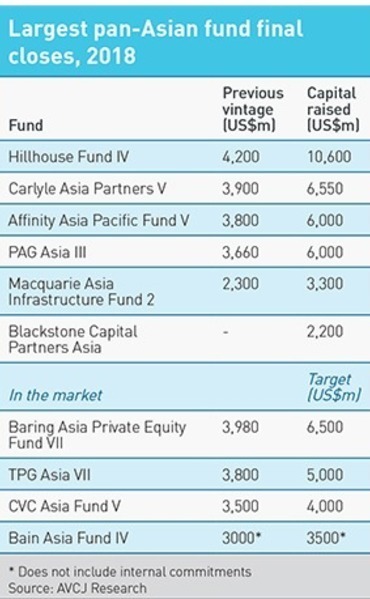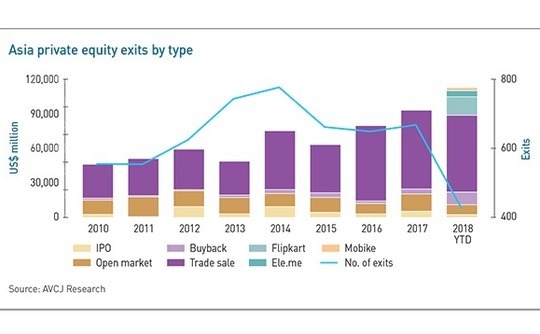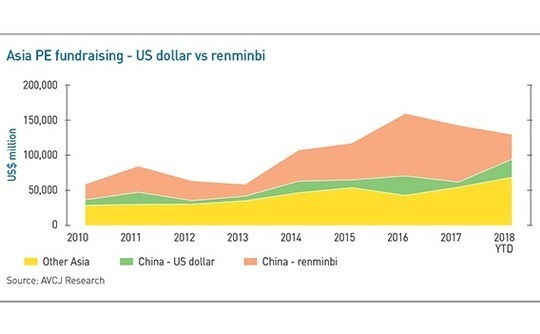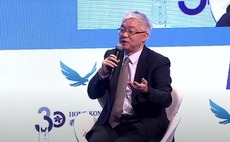
2018 in review: Volatility vortex

Pan-regional funds attract the bulk of capital while the renminbi space withers; mixed fortunes for internet IPOs and trade sales; big buyouts fail to deliver but growth-stage tech stays strong
Exits: An uncertain IPO pipeline
Wider market malaise hits post-IPO performance of tech stocks
BabyTree, a Chinese parent-focused social networking platform, raised HK$1.7 billion ($217.3 million) in its Hong Kong IPO in late November, achieving a market capitalization of $1.45 billion. Unfortunately for Alibaba Group's Taobao unit, which bought a 9.9% stake in the business earlier in the year, this was below its $2.1 billion entry valuation. The stock is currently trading at its IPO price and prevailing market conditions suggest Taobao will not be made whole any time soon.
The BabyTree situation captures a dilemma facing many of China's recently-listed unicorns. While early-stage investors are almost guaranteed a respectable return once a company goes public due to the ramp-up in valuations over the course of multiple private funding rounds, groups that arrived late in anticipation of a swift post-IPO mark-up might find themselves underwater.
Of the top 50 private equity-backed IPOs in Asia as of mid-December, 15 were listings by Chinese internet technology companies in Hong Kong or the US. Half are trading at discounts to their offering prices, while the other half are only enjoying modest premiums. Companies in the red include Xiaomi and Meituan-Dianping, which raised $4.7 billion and $4.2 billion, respectively, in the two largest IPOs of the year. Both valuations were below the targets mooted ahead of the listing process. Meituan-Dianping also faced a barrage of questions about the sustainability of its business model.
Xiaomi raised $1.1 billion at a valuation of $45 billion in 2014. Its market capitalization is now $43 billion. Meituan-Dianping is worth $36 billion, higher than the $30 billion valuation achieved when the company completed its most recent funding round in October 2017. Late-stage investors in several other newly-listed unicorns, including auto trading platform Uxin Group and online healthcare services provider Ping An Healthcare & Technology are also said to be facing markdowns based on public valuations.

As such, the post-IPO performance of Chinese tech companies might be more a function of general sentiment than specific problems, but the uncertain outlook has already prompted other listings to be pulled or postponed. The number of PE-backed offerings has slipped from 410 in 2017 to 150 so far this year, the lowest in five years. There were drop-offs in every significant Asian market, although most profoundly in China, which saw a more than threefold decrease.
Total proceeds from these offerings are holding up well against 2017 – $36.5 billion versus $40.9 billion – and this is largely thanks to the unicorn IPOs. Capital raised through PE-backed Chinse offerings on the US and Hong Kong exchanges are up around 100%, which offers a telling insight into the evolving competitive dynamic.
Hong Kong introduced weighted voting right (WVR) structures this year (enabling tech founders to retain control of their companies ever after their ownership is diluted) with a view to attracting tech listings that would previously have gone to the US. It has also started allowing public offerings by zero-revenue biotech companies. It represents an opening of the door, but only so far: listing candidates must meet reasonably stringent qualification criteria.
These new IPO channels still only apply to a minority of companies, but the strategy has proved so successful that Shanghai is looking to emulate it. However, with all these newly-listed businesses trading below their offering prices – Xiaomi, Meituan-Dianping, and four biotech players – it remains to be seen how investor sentiment develops.
Fundraising: The big get even bigger
Pan-regional players get larger share of capital committed to Asia
There are all kinds of reasons why an LP might commit to a pan-Asian fund. Maybe they are underweight on the region, want to increase their allocation, and stick to brand names due to a lack of familiarity with the market. Maybe they want to commit more capital to a smaller number of GPs and the increase in minimum check size means smaller funds cannot be considered. Maybe they believe that pan-regional strategies that target larger deals across multiple markets – rather than tying their fortunes to just one – will deliver the best returns.
Whatever the motivations, a small number of buyout funds continue to attract a disproportionate share of the total capital being allocated to Asia. In 2016, the top 10 funds, based on incremental and final closes, were responsible for 40% of non-renminbi denominated fundraising. Last year, it went to 50%. With a few weeks of 2018 still to run, the share is once again 50% but out of a record $93.7 billion raised. KKR set a new benchmark in 2017 by closing its third pan-regional fund at $9.3 billion, up from $6 billion for the previous vintage. Now everyone else is following suit.

Affinity Equity Partners took just four months to reach a first and final close on its fifth pan-regional vehicle of $6 billion, a 57% increase in size on Fund IV. The re-up rate was 95%, which meant there was little space for new investors, even if they could work within the condensed timeframe. PAG Asia Capital also raised $6 billion in a single close. The firm's previous fund was $3.66 billion.
The Carlyle Group eclipsed them both – in size if not speed – by collecting $6.55 billion for its fifth Asia buyout vehicle, having raised $3.9 billion last time around. Baring Private Equity Asia reached a first close of $4.5 billion on its seventh fund, and the firm is understood to have set the hard cap at $6.5 billion, which would represent a 63% increase on the previous vintage. Meanwhile, The Blackstone Group raised $2.3 billion for its debut Asian fund. Bain Capital, TPG Capital and CVC Capital Partners are all still in the market, having set targets ranging from $3.5 billion to $5 billion.
As the amount of dry powder in the region increases – there was $225 billion at the end of last year, up from $170 billion in 2016, according to Bain & Company – so do concerns about a mismatch between the investment opportunities available and the quantum of capital chasing them, especially in the large-cap space. The GP response is to upgrade sourcing with a view to avoiding expensive auctions or to find new angles on deals that can help justify valuations that appear elevated.
Investment: Big buyouts in freefall
Japan and the rest fail to deliver on their large-cap potential
Baring Private Equity Asia's rescue deal for struggling Japanese conglomerate Pioneer Corporation has evolved from a $538 million capital injection into a $903 million privatization. This revised plan for a company whose cash flow, and ability to service its debt, is rapidly dwindling has also inflated the overall private equity investment in Japan this year by 11%.
Twelve months ago, $365 million would have been a mere drop in the ocean. A record $24.9 billion was deployed in Japan in 2017, including four deals of $1 billion or more (a fifth was abandoned). The Bain Capital-led acquisition of Toshiba Memory Corporation headed the list at an eye-popping $17.8 billion. Baring's Pioneer investment is the largest of 2018 to date. Polaris Capital Group's $459 million purchase of Fujitsu Connected Technologies lies in second place. Both involved domestic corporates, but this isn't the large-scale carve-out opportunity that people have been talking about.
Japan is not an isolated case. Private equity investment in Asia reached $207.3 billion last year, thanks in no small part to $80.2 billion worth of buyout deals, a two-thirds increase on 2016. The buyout total has dwindled to $37.6 billion so far in 2018. With growth investment at a new high of $93.6 billion and VC experiencing only a modest decline to $30.5 billion, a paucity of buyouts is chiefly responsible for overall PE investment hitting $168.6 billion. This represents the second-highest annual total, but then the amount of capital available for deployment is rising too.
Had the proposed $17.6 billion privatization of KFC owner Yum China gone through, the numbers would look very different. Perhaps this suggests that buyout players are pulling back from expensive transactions in anticipation of an adjustment in valuations or sellers. Alternatively, they might be losing out to strategic players in a still robust Asian M&A market. There is no consensus view on the matter, while industry participants warn against trying to call the top of a cycle.
Nevertheless, there were 16 buyouts of $1 billion or more in 2017 – only two of them involved energy or infrastructure assets in Australia – and they were responsible for 28% of overall PE investment in Asia. China and Japan were both well-represented. For 2018 to date, only 10 transactions fall into this category and they account for 13.5% of capital deployed. The top three include a toll road in Sydney and a mine in Queensland.
Several other leading entrants have unusual origins: KKR agreed a $1.56 billion privatization of LCY Chemical Corp, its first foray into Taiwan since the acquisition of Yageo Corp. was blocked in 2011, which led to a protracted period of minimal buyout activity in the territory; and Hahn & Company's $3.7 billion restructuring of SK Shipping, said to be the first successful non-government led corporate restructuring in Korea's shipping industry.
A reduction in buyout activity has seen investment in China fall to $87.7 billion from $100.4 billion, but growth-stage technology transactions have once again put in a strong showing. There have been a dozen deals of $1 billion or more so far this year, led by a $14 billion round for Ant Financial – Alibaba Group's financial services affiliate – at a valuation in the region of $150 billion. About two-thirds count Alibaba or Tencent Holdings as investors or are aligned with one of them in some way.
China attracted 90% of the $56.1 billion that went into growth rounds for technology companies across the region, up from $15.6 billion last year. The dozen deals of $1 billion or more compares to three in 2017. Meanwhile, the number of transactions has risen from two to eight in the $500-999 million range and from 12 to 21 in the $200-499 million category.

Investors become increasingly creative in Asia
It was always a case of when, not if, the global trend for GP-led secondary restructurings involving brand-name private equity firms made its way to Asia. That moment came in early December as Lexington Partners backed a tender offer for TPG Capital's fifth and sixth Asia funds, taking out existing positions held by LPs and investing new capital into the firm's seventh pan-regional vehicle. A consortium led by the secondaries specialist committed around $1 billion in total.
It is by some distance the largest tender-plus-staple completed in Asia and emphasizes how private equity firms are beginning to think creatively about solving liquidity issues for LPs while simultaneously securing new capital for themselves. In the case of TPG, the transaction emerged after it became apparent that some LPs were either seeking liquidity or wanted to rebalance their exposure between funds.
That said, one sizeable transaction should not be allowed to overshadow the bigger picture in Asian secondaries. While the region has yet to achieve critical mass – it accounted for just 10.8% of global volume in 2017, according to Setter Capital – 2018 may go down as the year in which the market graduated to a new level, with a variety of deals concluded.
The slow-burn opportunity is restructuring the array of funds that are reaching the end of their lives but have yet to deliver enough exits. Managers are anxious to achieve liquidity in support of a new fundraise or they just want to leave the market. The consensus view is that $100-200 billion worth of fund commitments made in Asia between 2005 and 2010 could become available. India is seen as particularly attractive in this context and there continues to be a trickle of deals, with the local portfolio of New Enterprise Associates (NEA) most recently the subject of sale negotiations.
However, NewQuest Capital Partners – which has been linked to NEA – also worked on a transaction with Committed Advisors that saw $175 million committed to a new fund for a disparate portfolio of investments held by Basil Partners. The objective was to provide additional growth capital and an institutional structure for six technology companies that have yet to reach their potential.
Similarly, HarbourVest Partners led a deal worth $420 million that enabled Capital Today China Group to roll an investment from its first fund into a new single-asset vehicle. The target company, Yifeng Pharmacy, has become one of the largest retail pharmacy chains in China and there are expectations of additional upside. Capital Today is managing the new vehicle as well as making a substantial economic commitment to it.
Other investments add to the notion that secondaries players are becoming more ambitious and creative in their approaches – and targets increasingly willing to work with them. For example, Loyal Valley Capital was involved in renminbi-to-US dollar secondary deal, while the captive VC arm of Australian telecom giant Telstra was spun out as an independent entity with a combination of existing assets and new capital.
A $450 million stapled secondary for Southeast Asia's Southern Capital, completed by an AlpInvest Partners-led consortium, also served as a reminder that GP-led restructurings in support of new fundraising activities are not limited to global names.
Exits: Rise of the tech trade sale
Flipkart, Ele.me and Mobike drive regional exit activity
Asia private equity exits have surpassed $100 billion for the very first time – thank Flipkart, Ele.me, Mobike, and a reverse merger by Beijing Automotive Industry's electric vehicle unit. These four transactions account for nearly one-third of the record $90 billion in trade sale proceeds so far this year. With public share sales suffering due to market volatility, M&A is the key contributor to the $111.9 billion in overall exit value. This comes from fewer than 450 transactions, compared to more than 650 in 2017, which only serves to emphasize the influence of big-ticket deals.
Two years ago, Flipkart was a unicorn with growing pains. The Indian e-commerce giant was dealing with valuation markdowns, senior-level departures, the arrival of Amazon, and the collapse of a proposed merger with local rival Snapdeal. Last May, it became the subject of Asia's largest-ever trade sale when Walmart bought a 77% stake for $16 billion. The likes of Naspers and the SoftBank Vision Fund cashed out, while Tencent Holdings and Tiger Global were among those who stayed in.
The deal capped an acquisitive few weeks in Asia's technology space, following Alibaba Group buying the 57% of Chinese food delivery platform Ele.me it didn't already own at a valuation of $9.5 billion and online-to-offline services giant Meituan-Dianping purchasing local bike-sharing start-up Mobike for $2.7 billion in a cash-and-share deal. (The reverse merger of Beijing Electric Vehicle, which had a string of VC investors, was transacted over several months.)
The four exits are relevant from a venture perspective. Early investors prospered in each case, although the full extent of these returns is hard to capture. However, the Flipkart, Ele.me and Mobike transactions are perhaps most significant as demonstrations of strategic intent.
Walmart paid an 80% premium to Flipkart's most recent funding round because it wanted access to the Indian online shopping market. Its arrival will likely change the competitive dynamic with Amazon for both companies. Ele.me and Mobike, meanwhile, can be factored into the broader battle between Alibaba and Tencent. Alibaba threw its weight behind Ele.me having sold its stake in Meituan-Dianping, supposedly due to the company's perceived closeness to Tencent, another shareholder. Tencent is also an investor in Mobike, while Alibaba backs rival player Ofo.
These mega transactions will not necessarily become the norm, simply because internet companies become incredibly expensive once they reach scale. However, Chinese tech players, in particular, are increasingly active as minority investors – seeking partnerships with start-ups, often in other markets, to develop their own networks, knowledge, and capabilities.

Local currency fundraising in China falls off a cliff
Two years ago, seven of the 10 largest funds raised in Asia were renminbi-denominated and $0.55 out of every dollar committed went into a Chinese currency vehicle. As recently as 18 months ago, established GPs in the US dollar space were adding renminbi funds so they could tap the liquidity boom.
With 2018 nearly at an end, only three of the top 10 funds, based on incremental and final closes, are in renminbi. Local currency fundraising stands at $35.4 billion, compared to $80.4 billion last year. The number of vehicles achieving any kind of close has fallen by more than half to around 160. Total capital raised – which accounts for just over one-quarter of the $129 billion committed to private equity region-wide – is on course to be the lowest in five years.
Since 2010, the amount of money entering renminbi funds has comfortably outstripped China-focused US dollar vehicles; so far this year, the split is 58-42 in favor of renminbi. Managers with track records in the local currency space are now looking to raise US dollar vehicles.
There are several contributing factors to the deteriorating situation. High net worth individuals, who make the bulk of the domestic LP base, have lost confidence in wealth management platforms, driven by a meltdown in the peer-to-peer lending space as well as concerns about a general slowdown in the economy. Meanwhile, listed companies are preoccupied with falling public markets, and government guidance funds, though still active, lack commercial partners to join them in funds.
But the real turning point came in the second quarter when new rules curtailed participation by financial institutions in domestic private equity. The objective was to stop banks from playing fast and loose with the wealth management products typically used to raise money for PE funds – paying little attention to the origins of the capital, mixing up the proceeds with principal capital so that no one can figure out the returns, and deploying it opportunistically.
A shakeout is expected in the 24,000-plus local GP community in China as the remaining capital available – including allocations from the relatively shallow institutional investor segment – flows to top-tier managers.

Latest News
Asian GPs slow implementation of ESG policies - survey
Asia-based private equity firms are assigning more dedicated resources to environment, social, and governance (ESG) programmes, but policy changes have slowed in the past 12 months, in part due to concerns raised internally and by LPs, according to a...
Singapore fintech start-up LXA gets $10m seed round
New Enterprise Associates (NEA) has led a USD 10m seed round for Singapore’s LXA, a financial technology start-up launched by a former Asia senior executive at The Blackstone Group.
India's InCred announces $60m round, claims unicorn status
Indian non-bank lender InCred Financial Services said it has received INR 5bn (USD 60m) at a valuation of at least USD 1bn from unnamed investors including “a global private equity fund.”
Insight leads $50m round for Australia's Roller
Insight Partners has led a USD 50m round for Australia’s Roller, a venue management software provider specializing in family fun parks.








